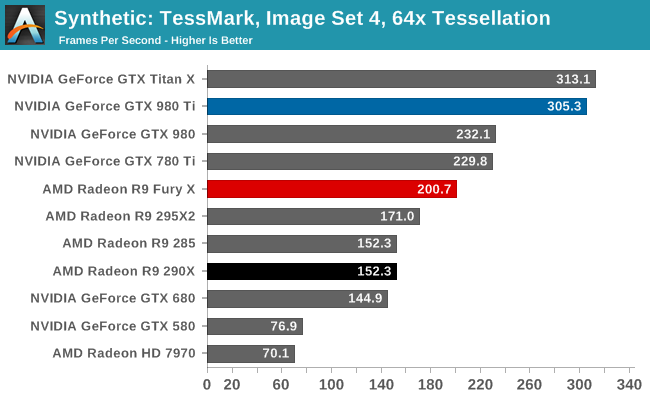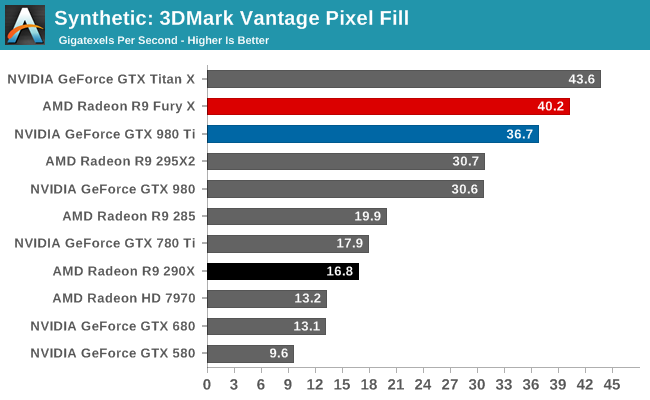The AMD Radeon R9 Fury X Review: Aiming For the Top
by Ryan Smith on July 2, 2015 11:15 AM ESTSynthetics
As always we’ll also take a quick look at synthetic performance. Since Fiji is based on the same GCN 1.2 architecture as Tonga (R9 285), we are not expecting too much new here.

First off we have tessellation performance. As we discussed in greater detail in our look at Fiji’s architecture, AMD has made some tessellation/geometry optimizations in GCN 1.2, and then went above and beyond that for Fiji. As a result tessellation performance on the R9 Fury X is even between than the R9 285 and the R9 290X, improving by about 33% in the case of TessMark. This is the best performing AMD product to date, besting even the R9 295X2. However AMD still won’t quite catch up to NVIDIA for the time being.

As for texture fillrates, the performance here is outstanding, though not unexpected. R9 Fury X has 256 texture units, the most of any single GPU card, and this increased texture fillrate is exactly in line with the theoretical predictions based on the increased number of texture units.

Finally, the 3DMark Vantage pixel fillrate test is not surprising, but it is none the less a solid and important outcome for AMD. Thanks to their delta frame buffer compression technology, they see the same kind of massive pixel fillrate improvements here as we saw on the R9 285 last year, and NVIDIA’s Maxwell 2 series. At this point R9 Fury X’s ROPs are pushing more than 40 billion pixels per second, a better than 2x improvement over the R9 290X despite the identical ROP count, and an important reminder of the potential impact of the combination of compression and HBM’s very high memory bandwidth. AMD’s ROPs are reaching efficiency levels simply not attainable before.










458 Comments
View All Comments
mikato - Tuesday, July 7, 2015 - link
Wow very interesting, thanks bugsy. I hope those guys at the various forums can work out the details and maybe a reputable tech reviewer will take a look.OrphanageExplosion - Saturday, July 4, 2015 - link
I'm still a bit perplexed about how AMD gets an absolute roasting for CrossFire frame-pacing - which only impacted a tiny amount of users - while the sub-optimal DirectX 11 driver (which will affect everyone to varying extents in CPU-bound scenarios) doesn't get anything like the same level of attention.I mean, AMD commands a niche when it comes to the value end of the market, but if you're combining a budget CPU with one of their value GPUs, chances are that in many games you're not going to see the same kind of performance you see from benchmarks carried out on mammoth i7 systems.
And here, we've reached a situation where not even the i7 benchmarking scenario can hide the impact of the driver on a $650 part, hence the poor 1440p performance (which is even worse at 1080p). Why invest all that R&D, time, effort and money into this mammoth piece of hardware and not improve the driver so we can actually see what it's capable of? Is AMD just sitting it out until DX12?
harrydr - Saturday, July 4, 2015 - link
With the black screen problem of r9 graphic cards not easy to support amd.Oxford Guy - Saturday, July 4, 2015 - link
Because lying to customers about VRAM performance, ROP count, and cache size is a far better way to conduct business.Oh, and the 970's specs are still false on Nvidia's website (claims 224 GB/s but that is impossible because of the 28 GB/s partition and the XOR contention — the more the slow partition is used the closer the other partition can get to the theoretical speed of 224 but the more it's used the more the faster partition is slowed by the 28 GB/s sloth — so a catch-22).
It's pretty amazing that Anandtech came out with a "Correcting the Specs" article but Nvidia is still claiming false numbers on their website.
Peichen - Monday, July 6, 2015 - link
And yet 970 is still faster. Nvidia is more efficient with resources than they let people on.Oxford Guy - Thursday, July 9, 2015 - link
The XOR contention and 28 GB/s sure is efficiency. If only the 8800 GT could have had VRAM that slow back in 2007.Gunbuster - Saturday, July 4, 2015 - link
Came for the chizow, was not disappointed.chizow - Monday, July 6, 2015 - link
:)madwolfa - Saturday, July 4, 2015 - link
"Throw a couple of these into a Micro-ATX SFF PC, and it will be the PSU, not the video cards, that become your biggest concern".I think the biggest concern here would be to fit a couple of 120mm radiators.
TheinsanegamerN - Saturday, July 4, 2015 - link
My current Micro-ATX case has room for dual 120mm rads and a 240mm rad. plenty of room there